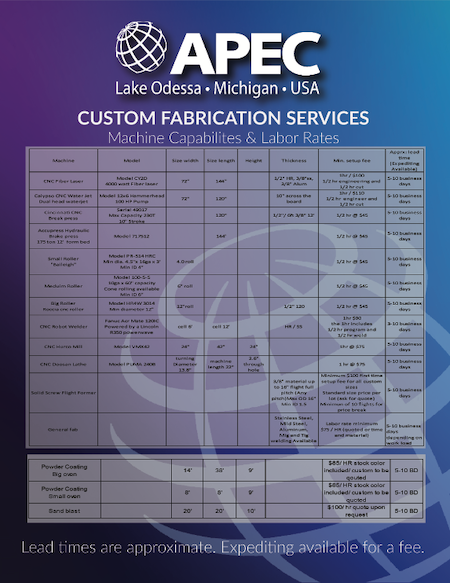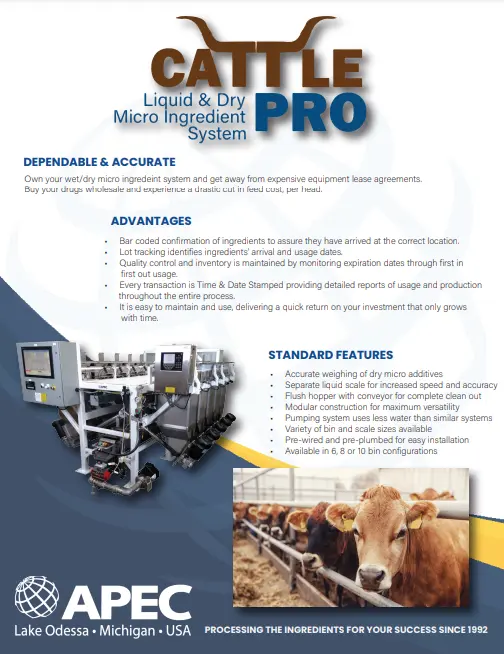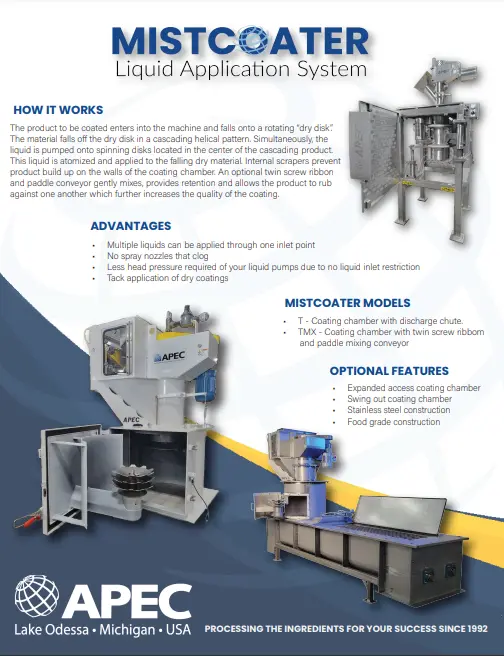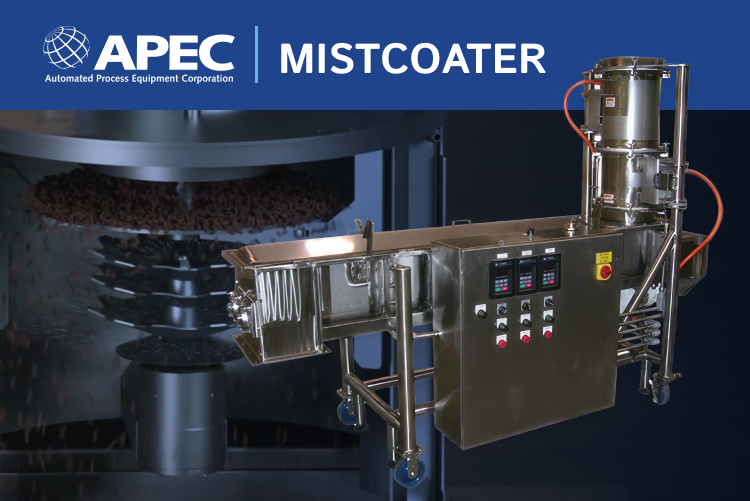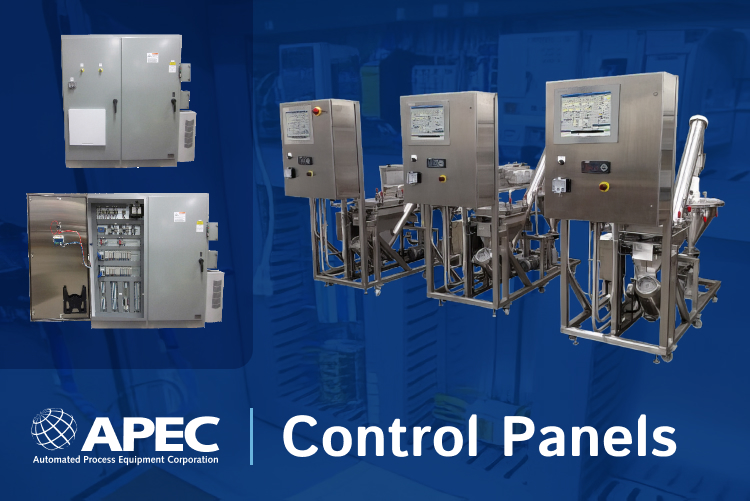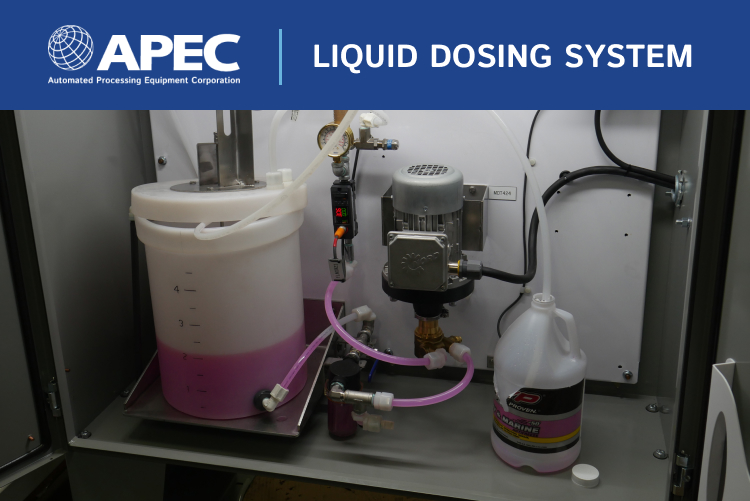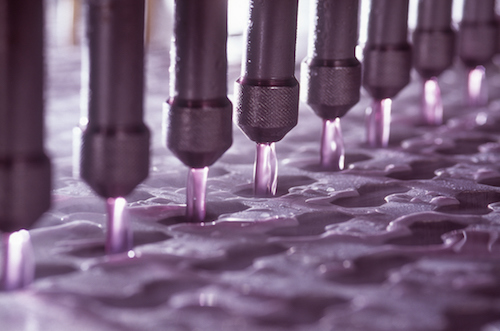
There are a number of ways to apply liquid coatings to foods and pet food. Using the right liquid coating equipment solutions for your coating type and product can improve product quality, and reduce waste, maintenance expenses, and downtime. In this blog post, we’ll discuss different liquid coating equipment solutions. We’ve updated this blog post in 2021 to give you more information about the latest liquid coating equipment solutions.
Comparing and Contrasting Liquid Coating Equipment Solutions
Screw Conveyor
 As extruded products move through a screw conveyor, they can also be coated. This requires the use of spray nozzles over the screw conveyor. However, the spray nozzles actually coat a relatively small portion of the product. This means the coating relies on mixing action to properly and uniformly coat the product. Spray liquid coating equipment solutions using screw conveyors don’t provide much mixing action and comparatively little retention. Reducing the screw conveyor flights or using ribbons in place of solid flights can improve the mixing action. Paddles with a slight pitch between the ribbon flights will move the product in the opposite direction of the conveyor, which can also improve the mixing action.
As extruded products move through a screw conveyor, they can also be coated. This requires the use of spray nozzles over the screw conveyor. However, the spray nozzles actually coat a relatively small portion of the product. This means the coating relies on mixing action to properly and uniformly coat the product. Spray liquid coating equipment solutions using screw conveyors don’t provide much mixing action and comparatively little retention. Reducing the screw conveyor flights or using ribbons in place of solid flights can improve the mixing action. Paddles with a slight pitch between the ribbon flights will move the product in the opposite direction of the conveyor, which can also improve the mixing action.
Ideal Application Method
Using a screw conveyor and spray nozzles is a popular method for coating materials. This arrangement can be used for many different liquid coatings and materials, though there are certain circumstances that are ideal. Since the spray nozzles can become clogged when working with liquids that contain high levels of fat, oils, sugars, or salts, it’s ideal to test the viscosity of the liquid first. Since the mixing action is essential to the liquid coating, but it can also break apart pellets or particles that are especially fragile, this method also works best for tougher materials that are likely to retain their shape.
Rotating Drum
The rotating drum is a common liquid coating equipment solution in food and pet food production. With this method, the product tumbles through a tilted drum, across raised flights on the inside. This system provides the unique advantage of adjustable retention. The drum also eliminates pinch points, which can cause fragile products to break. However, this method also has some disadvantages. Similar to the screw conveyor, the rotating drum requires mixing action to work. By putting the spray nozzles into a plenum prior to entry into the drum, this process can be improved.
Ideal Application Method
The rotating drum method is another popular liquid coating method. Since the mixing action is gentler compared to the screw conveyor, and doesn’t have pinch points, this operation can work better for more fragile pellets and other particles. Since this method also offers control over retention time, it can also work better for liquids that require longer periods to soak into the material. Since this method also requires spray nozzles, it’s ideal to work with liquids that aren’t prone to clog and don’t use excessive fats, oils, sugars or salts.
Rotating Disk
 The previous systems all use spray nozzles to coat the product. Systems using spray nozzles have a number of challenges. Spray nozzles can easily clog, especially when working with coatings with heavy fats, oils, sugars or salts. Liquid coating equipment solutions that bypass spray nozzles can avoid many problems resulting from clogs. Rotating disk applicators like the Mistcoater use spinning disks to apply liquid to the product. The liquid coating drops onto a disk spinning at a high RPM, which atomizes it into a fine mist and covers the product. This method not only provides uniform coating, but also requires less maintenance.
The previous systems all use spray nozzles to coat the product. Systems using spray nozzles have a number of challenges. Spray nozzles can easily clog, especially when working with coatings with heavy fats, oils, sugars or salts. Liquid coating equipment solutions that bypass spray nozzles can avoid many problems resulting from clogs. Rotating disk applicators like the Mistcoater use spinning disks to apply liquid to the product. The liquid coating drops onto a disk spinning at a high RPM, which atomizes it into a fine mist and covers the product. This method not only provides uniform coating, but also requires less maintenance.
Ideal Application Method
The rotating disk liquid coating system provides versatility and efficiency. Since the rotating disk applicator doesn’t require mixing action to coat the material, this can be ideal for fragile pellets and particles. Since there are no nozzles to clog, this can also work well for liquids with a high oil, fat, sugar or salt content. For systems that are prone to clogging or crumbling fragile particles, a spinning disk system can be an ideal upgrade to reduce maintenance costs, reduce material loss, and improve finished product quality.
Batch Mixer
These liquid coating equipment solutions are usually located just before load-out or packaging. These mixers used paddles, or a combination of ribbons and paddles to move coatings over the material. This allows the product to move through the mixer quickly without getting damaged. A vacuum can also be drawn on this mixer, allowing it to draw the air out of the product and then draw liquid into the product when the vacuum is released. With this system, it’s also easier to add a light level of liquid to the product. The disadvantage is that this system requires more headroom, and it can be expensive.
Ideal Application Method
The batch mixer liquid coating method also offers versatility and efficiency. With the ability to choose between vacuum coating and mixing action to coat the materials, it’s easier to accommodate a wider array of materials and liquids with varying properties. Vacuum coating can help to increase liquid retention, as it allows the liquid coating to enter the pores of the pellets or granules. This method also makes it possible to add multiple liquid layers to the product. If the liquid coatings require separate applications to retain their properties or to fully absorb into the product, combining batch mixing with vacuum coating may work best.
Each of these methods has advantages and disadvantages. Finding the right liquid coating equipment solutions means finding a good fit for your product, coating, and the rest of your existing equipment. Work closely with your system engineer and provide as much information as possible about the coating and materials you’re working with. This will help you to optimize your system.


